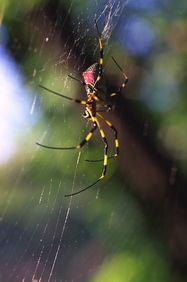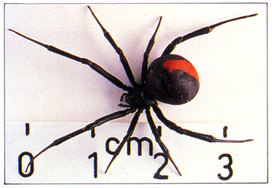 Jorogumo spider. Image by John Harvey Jorogumo spider. Image by John Harvey I have a revolving door policy for insects great and small in my house; the logic being that big insects (spiders) eat small pesky ones (roaches, earwigs, mosquitoes, fruit flies and clothes moths). Which is generally a good thing—until the wet season arrives in western Japan. The first meaningful rain of June fell last night: a long, slow drizzle that filled the flower pots and beat down on the roof tiles of the empty houses in my neighborhood. It is a precursor to the equally long and torrid wet season, now looming off the coast of southern Japan. Not only does rain bring restlessness to my old house (timbers expand, paper doors ripple, tatami mats sag) but to the insects who venture from its nooks and crannies in search of food and romance. Or, where my living room is concerned, liquor and late night TV. So the long rain fell on into the night and there was nothing for it but to ease out the tide on a bottle of Black Mist Island shōchū (焼酎) and watch Zatoichi, a film about a blind ronin who wanders the highways of old Japan slaying anyone annoying or who smells bad. I jiggled my ice cubes, listened to the thunder and waited for Zatoichi’s next head to roll. In the darkened corner of the room something moved. From beneath the tokonoma (a sacred hearth kept by most traditional Japanese houses), a monster yorugumo, or night spider, emerged. This was no washed-out Incy-wincy—it crossed the tatami mats like a small cavalry unit with the leg-span of a kid’s tricycle wheel. Zatoichi hid in the shadows. The next evening the spider was back, drumming his feet on my paper sliding door, looking unimpressed, and in the words of Raymond Chandler, “as inconspicuous as a tarantula on a slice of angel food cake.” A tarantula? This huge, hairy bastard would have eaten ‘em with cornflakes! Now I don’t like to kill anything, but since the cockroaches had disappeared, I wondered what next lay up the food chain? Then I remembered an old Japanese superstition: “if you spy a spider in the morning (asagumo), you shouldn’t kill it. But if it is a night spider (yorugumo), then it means bad luck and you should SMASH it!” I pulled from the closet my Toshiba GH-0971 and plugged it in. The room vibrated with the sweet sound of doom. The spider broke into a gallop—the cavalry headed for Death Valley. The great thing about the Toshiba GH-0971 is that it has extensions! A large insect going up one sounds a lot like a fat man being blasted from a cannon (only in reverse). That strange plopping noise caused me to reflect. I said three なむだぶなむだぶ, invoking the name of Buddha, and returned the GH-0971 to its mantel. Guess I should blame the warm, humid southerlies rising from the Philippines for this mega-fauna. Rain sets off a growth spurt which culminates in an abundance of bug life; spider webs festoon the telephone lines, abandoned houses, disused bicycles and futon-drying poles of my neighborhood. Japanese folklore endows these creatures with supernatural abilities—to transform into boys or women, like the large-bodied Tsuchigumo, or Earth spider, which tries to lure the samurai commander Minamoto no Yorimitsu (top picture) to his death, but is itself fatally vanquished in one famous tale. Or the Jorōgumo (the “femme fatale" spider), which is said to assume the body of a beautiful woman and to have once seduced passing samurai, whereupon she wrapped them in silk and sucked them alive. Actually a member of the golden orb spider family, the jorōgumo is venerated as a goddess at the Jōren Falls on the Izu Peninsula, where she is said to save people from drowning. From mythical doom to modern day gloom, the new scourge, according to the Japanese media, is the Australian redback spider ‘plague.’ Did you hear correctly? Yes, you did. The story goes that, 20 years ago a container ship carrying Australian wood chips docked at Osaka port and, once the captain and his Filipino crew had taken leave, the redbacks (Latrodectus hasseltii) slipped on their Hawaiian shirts, sunglasses, and with extra supplies alpha-latroxin taped to their chests, sneaked by Osaka Customs and Quarantine to kiss the earth of their new homeland.  Unwanted and unloved - Latrodectus hasseltii, aka redback spider. Unwanted and unloved - Latrodectus hasseltii, aka redback spider. I loathe journalistic shortcuts like “Experts estimate…” but let me use it just this once: “Experts estimate there are now more than 19,000 redbacks in Japan. As of Oct 20, 2014, 100 people had been bitten with no fatalities.” According to the Australian Broadcasting Corporation report, a nice man named Dr Koichi Goka from the National Institute for Environmental Studies, believes the Japanese medical system is not prepared for the spread of this spider: “The medical system is behind. They have anti-venom in Osaka and Fukuoka but other provinces don't have supplies. So it's a serious issue and hasn't been addressed," he said. The report also says that the spiders have no natural enemies here and that heating systems (toilet seats noted) have helped the spiders to survive Japan’s cold winters. And finally, this gem: “Japan experts warn it is possible that redbacks could mutate and return to Australia with a stronger, more toxic bit.” Are you kidding me? Why would anyone in their right mind want to leave a country with heated public toilet seats?
0 Comments
Leave a Reply. |
This Blog:What is the essence of a traditional Japanese neighbourhood? Writing from my home in Himeji, a castle town in western Honshu, Seaweed Salad Days distills, ferments, presents! Archives
March 2024
Categories
All
|

 RSS Feed
RSS Feed
